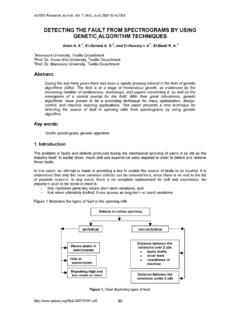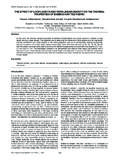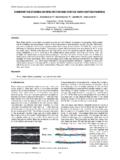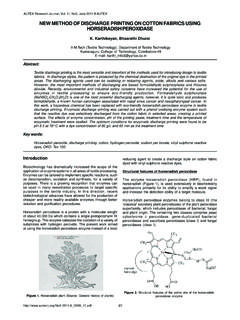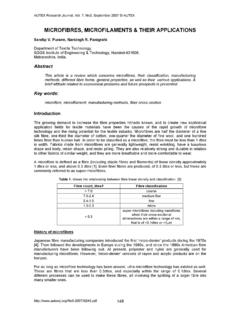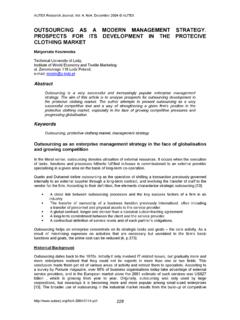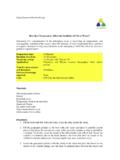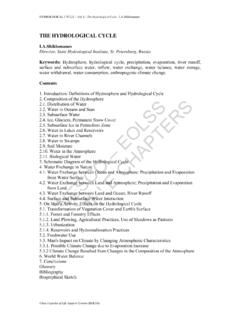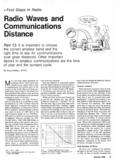Transcription of MOISTURE TRANSMISSION THROUGH TEXTILES Part I: …
1 AUTEX Research Journal, Vol. 7, No2, June 2007 AUTEX 100 MOISTURE TRANSMISSION THROUGH TEXTILES part I: Processes involved in MOISTURE TRANSMISSION and the factors at play Brojeswari Das1, A. Das1, Kothari1, R. Fanguiero2 and M. de Ara jo2 1 Department of Textile Technology, Indian Institute of Technology, Delhi, India, 2 Department of Textile Engineering, University of Minho, Guimar es, Portugal Abstract: MOISTURE TRANSMISSION THROUGH TEXTILES has a great influence on the thermo-physiological comfort of the human body which is maintained by perspiring both in vapour and liquid form. The clothing to be worn should allow this perspiration to be transferred to the atmosphere in order to maintaining the thermal balance of the body.
2 Diffusion, absorption-desorption and convection of vapour perspiration along with wetting and wicking of liquid perspiration play a significant role in maintaining thermo-physiological comfort. The scientific understanding of the processes involved in MOISTURE TRANSMISSION THROUGH TEXTILES and the factors affecting these processes are important to designing fabrics and clothing assemblies with efficient MOISTURE transfer in different environment and workload conditions. This paper is in two parts. part I focuses on the MOISTURE TRANSMISSION THROUGH textile materials and it discusses the processes involved in MOISTURE TRANSMISSION and the key influencing factors at play to maintaining comfort.
3 It is underlined that the processes which play the major role in MOISTURE TRANSMISSION in a particular situation are dependant on the MOISTURE content of the fabric, the type of material used, the perspiration rate and the atmospheric conditions, such as humidity, temperature and wind speed. part II is concerned with the selection of the measurement techniques which are of great importance in determining fabric factors that influence comfort. The instruments and methods used for testing purposes should adequately simulate the exact conditions for which the fabric will be used, in order to determine the effectiveness of that fabric for a particular wearing situation and environmental condition.
4 The testing methods used and the apparatus developed by different researchers for determining MOISTURE TRANSMISSION THROUGH TEXTILES by different mechanisms are discussed in this paper. Moreover, this part of the paper deals with the mathematical models of liquid and vapour transport THROUGH textile materials developed by several scientists in order to understand the exact phenomena involved and to predict the factors affecting the TRANSMISSION under a particular condition. When designing the comfort of a clothing product for a particular application, the requirements may result from needs concerning the application, the individual wearer and the environmental conditions.
5 Key words: Thermophysiological comfort, diffusion, absorption, condensation, wicking, heat transfer Introduction Comfort is a pleasant state of psychological, physiological and physical harmony between the human being and the environment [1]. The processes involved in human comfort are physical, thermo-physiological, neuro-physiological and psychological [2]. Thermo-physiological comfort is associated with the thermal balance of the human body, which strives to maintain a constant body core temperature of about 370C and a rise or fall of ~ 50C can be fatal [3]. Hypothermia and hyperthermia AUTEX Research Journal, Vol. 7, No2, June 2007 AUTEX 101may result, respectively, due to the deficiency or excess of heat in the body, which is considered to be a significant factor in limiting work performance [4].
6 In a regular atmospheric condition and during normal activity levels, the heat produced by the metabolism is liberated to the atmosphere by conduction, convection and radiation and the body perspires in vapour form to maintain the body temperature. However, at higher activity levels and/ or at higher atmospheric temperatures, the production of heat is very high and for the heat TRANSMISSION from the skin to the atmosphere to decrease, the sweat glands are activated to produce liquid perspiration as well. The vapour form of perspiration is known as insensible perspiration and the liquid form as sensible perspiration [5]. When the perspiration is transferred to the atmosphere, it carries heat (latent as well as sensible) thus reducing the body temperature.
7 The fabric being worn should allow the perspiration to pass THROUGH , otherwise it will result in discomfort. The perception of discomfort in the active case depends on the degree of skin wetness. During sweating, if the clothing MOISTURE transfer rate is slow, the relative and absolute humidity levels of the clothing microclimate will increase suppressing the evaporation of sweat. This will increase rectal and skin temperatures, resulting in heat stress [6]. It is also important to reduce the degradation of thermal insulation caused by MOISTURE build-up. If the ratio of evaporated sweat and produced sweat is very low, MOISTURE will be accumulated in the inner layer of the fabric system, thus reducing the thermal insulation of clothing [6] and causing unwanted loss in body heat.
8 Therefore, both in hot and cold weather and during normal and high activity levels, MOISTURE TRANSMISSION THROUGH fabrics plays a major role in maintaining the wearer s body at comfort. Hence, a clear understanding of the role of MOISTURE TRANSMISSION THROUGH clothing in relation to body comfort is essential for designing high performance fabrics for particular applications. Processes involved in MOISTURE TRANSMISSION THROUGH TEXTILES The process of MOISTURE transport THROUGH clothing under transient humidity conditions is an important factor which influences the dynamic comfort of the wearer in practical use. MOISTURE may transfer THROUGH textile materials in vapour and in liquid form, as outlined bellow.
9 Water vapour TRANSMISSION Water vapour can pass THROUGH textile layers by the following mechanisms: Diffusion of the water vapour THROUGH the layers. Absorption, TRANSMISSION and desorption of the water vapour by the fibres. Adsorption and migration of the water vapour along the fibre surface. TRANSMISSION of water vapour by forced convection. The diffusion process In the diffusion process, the vapour pressure gradient acts as a driving force in the TRANSMISSION of MOISTURE from one side of a textile layer to the other. The relation between the flux of the diffusing substance and the concentration gradient was first postulated by Fick [8]. AxJ = dxdCAABD (1) Where, AxJ is the rate of MOISTURE flux; dxdCA is the concentration gradient; and DAB is the diffusion coefficient or mass diffusivity of one component, diffusing THROUGH another media.
10 Water vapour can diffuse THROUGH a textile structure in two ways, simple diffusion THROUGH the air spaces between the fibres and yarns and along the fibre itself [9,10]. In the case of diffusion along the fibre, water vapour diffuses from the inner surface of the fabric to the fibres surface and then travels along the interior of the fibres and its surface, reaching the outer fabric surface. At a specific concentration gradient the diffusion rate along the textile material depends on the porosity of the material and also on the water vapour diffusivity of the fibre. The diffusion co-efficient of water vapour THROUGH air is cm2/sec and THROUGH a cotton fabric is around 10-7cm2/sec.
